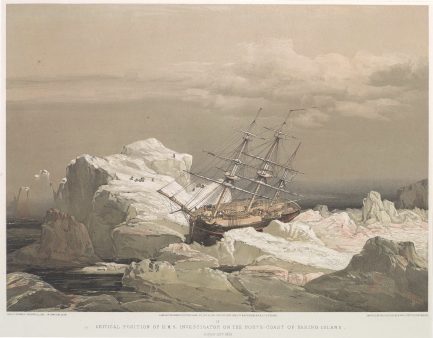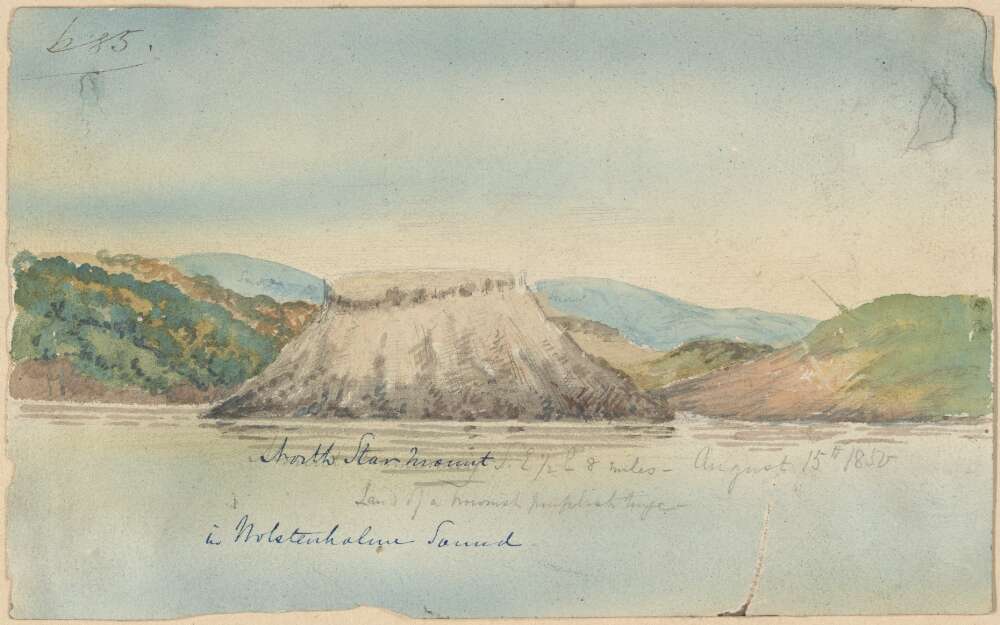“But what was there to Draw? Isn’t it all just Ice?” – Visual Culture and Arctic Voyages
31 May 2022
By Eavan O’Dochartaigh
In the winter of 1852, Walter William May was industriously engaged in several visual projects. Amongst other things, he was painting theatrical scenery, drawing comic illustrations for a new magazine, and preparing dissolving views (1) for Christmas. Walter was not an artist by trade but a young lieutenant aboard a British naval ship, the Assistance, which was frozen into winter quarters at 77° north, deep in the Canadian Arctic Archipelago in present-day Nunavut.
The Assistance was part of a huge effort that was being undertaken to try and locate the missing Franklin expedition of 1845 that had disappeared into the Northwest Passage. To the disappointment of some on my research committee, my PhD thesis, from which my new book evolved, was not about the Franklin expedition and had (almost) no cannibalism in it. Rather, I was interested in the visual and textual archival records of the expeditions that searched for Franklin. Many public visual images and texts evolved from those records to create a perception of the Arctic that still circulates in the twenty-first century. In the book, Visual Culture and Arctic Voyages, I look in more detail at the work by Walter and others who participated on British naval expeditions to the Northwest Passage in the mid-nineteenth century.
Images have a lot to answer for. Anyone who even takes a glance at Arctic exploration history will quickly become familiar with heroic explorers, ships perilously trapped in ice, and … at least one polar bear. Samuel Gurney Cresswell’s celebrated lithograph Critical Position of H.M.S Investigator (1854) is probably one of the most well-known images used in connection with the history of the Northwest Passage, British exploration in the Arctic, and the Franklin search in particular. And no wonder, it has many of the hallmarks we have come to expect of nineteenth-century British exploration of the Arctic: threatening ice; stormy skies; a ship in peril; and the tiny figures lost in the sublimity of nature.
I began to notice an alternative narrative that ran alongside, or perhaps beneath, the dominant public narrative of British Arctic exploration. This became apparent in small unassuming sketches, faded watercolours, and scribbled manuscripts. It was sometimes a more genial narrative, that included summer, humour, domesticity, and assistance from Indigenous people – themes that are not usually stressed in the public narrative, which relies on the sublime, darkness, and yes, polar bears, to create a breath-taking stage where the adventures of British (and other white male) explorers could be re-enacted.
While it might be tempting to dismiss some of these pictures as ‘not very good’ from an artistic point of view, their contents and condition have the potential to tell us more about Arctic exploration in the nineteenth century. Even published pictures can sometimes tell a different story but these smaller and more nuanced narratives were overwhelmed by the vast quantities of material that showed icy seas, danger, and darkness.

In the book Visual Culture and Arctic Voyages, I look at both the personal and the public images and texts from the search expeditions. I look closely at pictures themselves, noticing how they interact with text, or how small details can change the mood of pictures and words. The book moves from the ship to the shore, with the first two chapters dedicated to visual culture aboard ship: documentary sketches, paintings, early photographs, and illustrated periodicals (the latter being a strong feature of the British naval search expeditions on which the book focuses). The final three chapters investigate how the image of the Arctic was brought to the metropole through a range of published Arctic exploration narratives, a panorama (2), and folios of lithographic prints. Throughout the book I connect the archival and published material to the geography of the Arctic; maps were an important part of both the research and the publication, emphasising that the Arctic environment is not one homogenous region. In this way, the book is an interdisciplinary work traversing historical geography, the study of literature, and the history of art.
Finally, I was fortunate that funding from a Marie Skłodowska-Curie Individual Fellowship (3) could be used to pay for the book’s availability as a gold open access title on Cambridge Core while funding from the Arctic Research Centre at Umeå University was put towards other costs. As for Walter, he did, in the end, leave the Navy to become a professional marine painter.
1. Dissolving views used lanterns to superimpose images that faded into each other and gave the impression of the gradual transformation of a scene.
2. The original panorama was an enormous circular painting that spectators viewed by standing on a raised platform in the centre. They were popular and inexpensive forms of entertainment in the nineteenth century.
3. The project received funding from the European Union’s Horizon 2020 research and innovation programme under grant agreement No. 839477. The PhD was funded by a Government of Ireland Postgraduate Scholarship and a Galway University Foundation Hardiman Scholarship.
Eavan O’Dochartaigh is an SFI-IRC Pathway Programme Awardee at National University of Ireland Galway. Her first book, Visual Culture and Arctic Voyages (2022), has recently been published by Cambridge University Press and is available as open access on Cambridge Core.
- From the Floe Edge: Visualising Sea Ice in Kinngait, Nunavut
- Bridging Knowledge and Action: A Polish-Norwegian Perspective on Arctic Science-Policy Collaboration
- Unpacking the Motivation Behind Wintering at Polar Stations
- Working the Ocean’s White Gold: A Nutshell History of a Living Bering Strait Tradition
- Political Participation in the Arctic: Who is heard, when, and how?